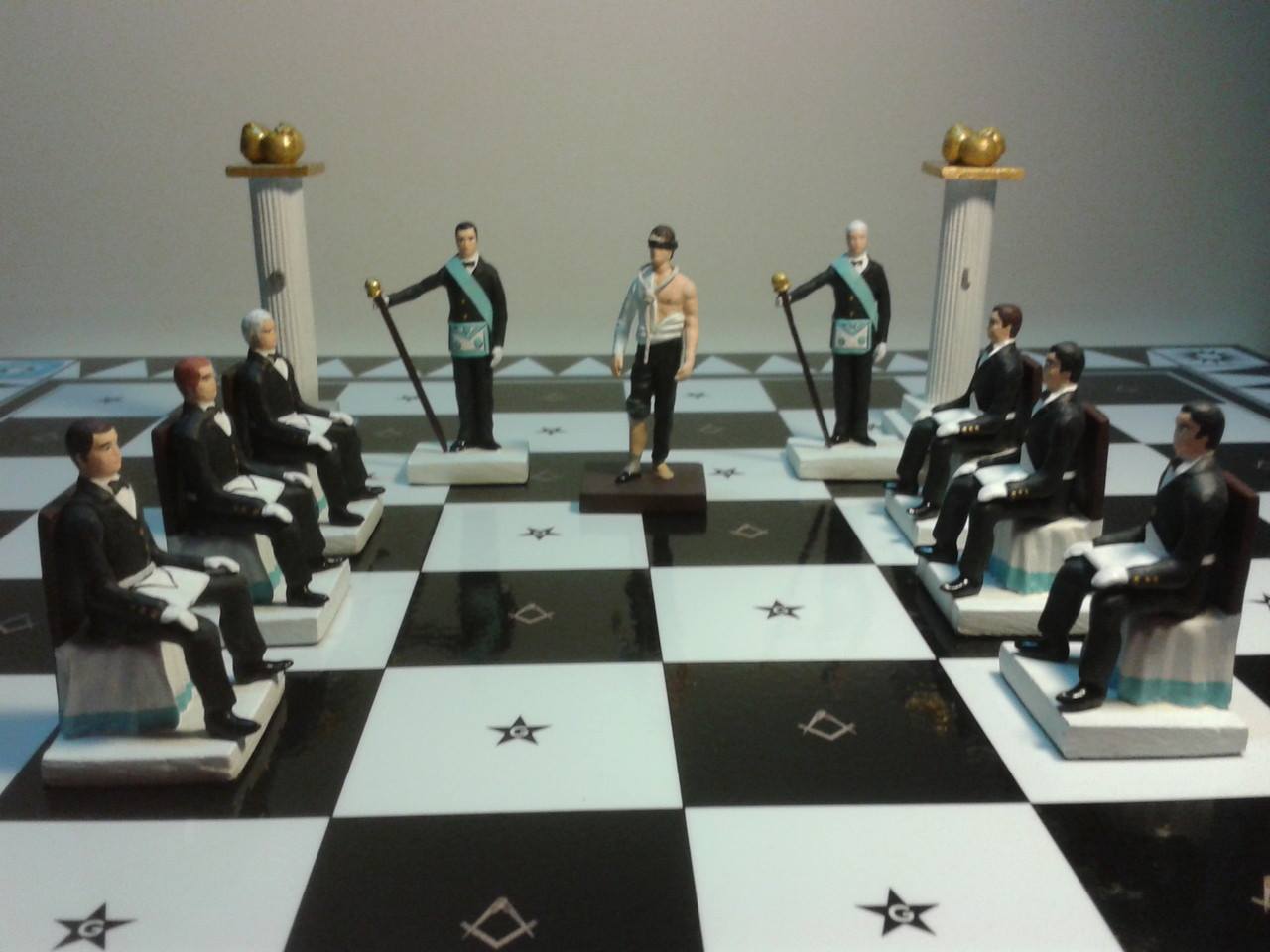
Chess is an ancient game of skill and strategy played within the confines of strictly defined rules of play, within which the participants have the freedom to exercise individual decisions (free will). Each decision has a consequence which affects the response of the opponent and future moves of the decision maker, thereby influencing the outcome of the game. I have purposefully described the game in this somewhat unusual manner in order to emphasise the similarity between chess and the internal and external struggles of life. The internal aspects are the struggles between our dual natures and include those spiritual conflicts by which we maintain our self-identity, rationalise our behaviour and live our lives. The external struggles include the mundane stresses associated with living in the material world, preserving our physical well being, and survival. Ultimately, the game represents man’s exercise of free will while operating within the confines of natural law. This parallel between the game of chess and our material lives is a paramount factor in grasping the esoteric properties which find active expression not only in the game of Chess, but also in Freemasonry.
Brother Manly P. Hall said[I], concerning the Game of Chess:
In its symbolism chess is the most significant of all games. It has been called “the royal game”–the pastime of kings. Like the Tarot cards, the chessmen represent the elements of life and philosophy.
In Chess, the playing field is defined by the chess board upon which the chess pieces operate. The physical constraints of the board, combined with the limitations of movement prescribed for each chess piece on that board, and together with the rules and conventions of the game constitute the totality of the tools used equally in common by each participant. The tools unique to each participant are the mental and spiritual processes brought to bear during play. The challenge of the game increases in direct proportion to the match in the degree of skill of the participants.
This paper will deal primarily with the physical characteristics of the Chess board, the functions of the Chess pieces and the esoteric symbolism which these game elements exhibit. It will address the intangible spiritual elements in the context of the physical. The premise of the paper is that not only is there a strong esoteric symbolism present in the game of Chess, this symbolism may be positively correlated with Esoteric concepts found in Freemasonry.
Since I have taken the approach of dividing the physical elements of the game into the board, and the chess pieces respectively, I will discuss these elements in that same order. First however, a brief summary of the history of the game is offered.
Historical Elements
The game of Chess is believed to have originated in Persia[II]. Legend holds that the game was developed for King Vishtaspa by the prophet Zarathutra[III] who requested as a reward that he receive payment in grain. The conditions of this reward were that the amount of grain received would be equal to that which accumulated by placing one grain on the first square of the chess board, three on the second, six on the third, ten on the fourth, etc. up to the sixty-fourth and final square. Mathematicians will recognize this to be a geometric progression, resulting in a greater quantity of grain than could be gathered in the entire Persian Empire (18,446,744,973,709,551,661 grains). According to further legend, the original rules of the game of Chess were so ancient as to have been lost. A wise man in the Persian court by the name of Buzurdjmir, rediscovered the complete set of rules for the game of Chess, including the placement and movement of each Chess Piece on the board through study and analysis. Dr. Ricardo Calvo[IV] says of Buzurdjmir:
To calculate the arithmetical progression upon the chess board, he considered 32 pairs of numbers adding up to 65 (1+64 = 65, 2+63 = 65, 3+62 = 65 etc). So 32×65 = 2080… In an allegorical sense, the secret number of the chess board is not 64, but 65, because all other numbers are related to it.”
The word “Checkmate” used to signify the games end by successfully trapping the King, is believed to stem from the Persian word “Shah” (king) and the Arabic word “mat” (he is dead).
Other accounts of the origin of the game[V] hold that it began in India as early as the time of the great Indian grammarian Pānini (circa 500 BC) where it was a game known as “Chaturanga” (Sanskrit meaning “four members”) which required four participants, and which possibly included the use of dice. It is interesting to note that by using dice, the element of fate was introduced as a factor in the game. In the Indian version of the game, the sixty-four squares (in an 8 X 8 matrix) correspond to the so-called Vastu-mandala, a diagram associated with the layout of sacred temples. The Hindu King Balhit[VI] is attributed with writing a book about the game of Chess in which the Game is portrayed as an allegory of the Zodiac. According to historian[VII] Titus Burhhardt:
“ The cyclic symbolism of the chess-board resides in the fact that it expresses the unfolding of space according to the quaternary and octonary of the principle directions (4 X 4 X 4 = 8 X 8), and that it synthesizes in crystalline form, the two great complementary cycles of sun and moon: the duodenary of the Zodiac and the 28 Lunar mansions; furthermore, the number 64, the sum of the squares on the chess-board is a submultiple of the fundamental cyclic number 25920, which measures the precession of the equinoxes.” .
The representation of the Chess board in this fashion brings to mind similarities of the Vastu-mandala and the Kabalistic Cube of Space.
Still other sources identify that the game of Chess was invented by Mercury, also known as Hermes or Thoth. Regardless of its origin, the game of Chess became extremely popular in the Arabic world, thereby spreading to Spain and eventually to the rest of the Western world.
The Chess Board
The traditional Chess board is an eight-by-eight mosaic of sixty-four squares arranged in alternating dark and light shades (Figure 1). The squares are arranged in ranks and files; ranks are the rows or lines of eight squares running from left-to-right across the board, whereas files are the rows or lines of eight squares running from top-to-bottom along the board. Ranks are commonly numbered from 1 to 8, and files are lettered from “a” to “h” (left-to-right).
The board is commonly viewed to be divided into four zones. The first zone is the division of the board into the White v. Black Half into groups of four Ranks. Traditionally, white’s half of the board consists of all of the squares from Ranks 1 to 4; Black’s Half includes all the squares from Ranks 5 to 8. A similar, but vertical division creates a second zone delineating the Kings Side versus the Queen’s Side of the board. The Queen’s Side includes all squares from Files a through d, whereas the King’s Side includes all squares from Files E to F. The third zone is actually a combination of the Center and the Expanded Center of the Board. The Center includes the four most center squares on the chessboard; whereas the Expanded Center includes the 16 squares in the board center. The fourth and final zone consists of the Flanks. There are 6 Flanking squares in total, 3 squares on the Queen’s Side (Files a to c) and 3 squares on the Kingside (Files f to h).
While the game is now traditionally played by two participants, there have been four-handed versions such as Rosicrucian or Enochian Chess[VIII] which appear to be an adaptation of the earlier “Chaturanga”. In 1922 George Slater, a member of the Sodalitas Rosae + Crucis & Solis Altati (The Rosicrucian Order of A.O.) prepared a detailed description of the game of Enochian Chess and a ritual associated with the game, which has been transcribed and is available via the internet[IX]. In this transcript, a Table is provided which gives correspondences between the Chess Pieces, Cards of the Tarot, and the Elements.
There are correlations between the 64 Squares of the Chess Board and the 64 Hexagrams of the Oriental divinatory system known as the I-Ching[X]. The 8 major trigrams of the I-Ching coincide with the 8 ranks and 8 files of the Chess Board, and the six lines in a hexagram may be correlated with the 6 types of chess pieces. There are also similarities between certain of the Chess Pieces and the cards in a Tarot deck. As is frequently the case when exploring true esoteric symbolism, there is a great deal of similarity which can be found between different, seemingly unrelated systems.
The Masonic allusion most commonly associated with the Chess Board is that of the Mosaic pavement, and the allegorical representation of the dark and light squares as symbols of opposites. Somewhat less recognized are the allusions of the Chess Board to astrological concepts (see earlier references to the book of King Balhit) and the similar allusions to the Astrological layout[XI] of the lodge. During our later discussion of the Chess Pieces further astrological allusions shared in common between the game and the lodge will be explored.
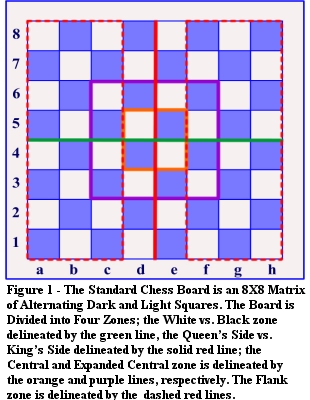 A somewhat lesser-known allusion concerning both the Chess Board and the Mosaic Pavement also exists in the Masonic allegory of the 3, 5, and 7 steps leading to the middle chamber. The numbers 3, 5, and 7 represent the difference of squares of the first four integers as follows:
A somewhat lesser-known allusion concerning both the Chess Board and the Mosaic Pavement also exists in the Masonic allegory of the 3, 5, and 7 steps leading to the middle chamber. The numbers 3, 5, and 7 represent the difference of squares of the first four integers as follows:
12 = 1,
22 = 4,
32 = 9,
42 = 16
Subtracting the square of each integer
4 – 1 = 3
9 – 4 = 5
16 – 9 = 7
Although logic indicates a continuance of the sequence could be obtained by squaring the integer 5, and thereby deriving a difference of squares (25 – 16 = 9), it is important to note that the numbers 3, 5, and 7 are all primes (indivisible by any number other than 1 or themselves), whereas 9 is not a prime number. As will be shown, only the 3, 5, 7 sequence is accommodated by the Chess Board. The squaring of the integers may be represented graphically as shown in Figure 2:
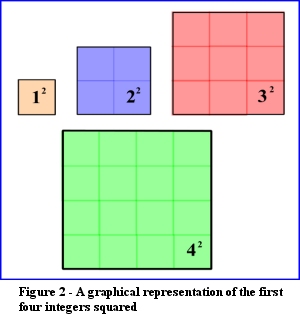
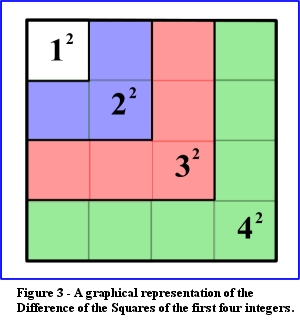
The difference (subtraction) of squares may also be represented graphically as depicted in Figure 3:
The Chess Board may be discovered to have a common center, which can be located at the point of intersection of diagonals constructed from the four corners of the board. This is true also of the Masonic Pavement[XII]. In a manner identical to that used in the layout of the Masonic Pavement, the Chess Board is constructed from its center outwards in four concentric rings with each quadrant of the board encompassing four groups of nested squares (See Figure 4) which are identical to the nested squares associated with the 3, 5, 7 sequence shown in Figure 3. Among other things, the arrangement of the nested 3, 5, 7 Difference in Squares incorporates an approximation of the Golden Spiral[XIII].
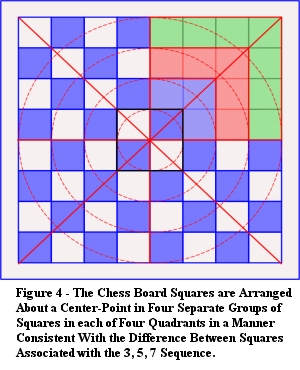 One of the key features of the Board Layout when envisioned as nested squares derived from the 3, 5, and 7 sequence is that when all four quadrants are considered there is a central common group of four contiguous squares (shown in black outline in Figure 4). The only two Chess pieces which are capable of simultaneously controlling all four of this group of squares are the King and Queen. Four (4) is a cubic number (and 4 X 4 X 4 = 64). In this regards, the four squares, which in a Masonic Mosaic Pavement would be occupied by the Altar, represent the Holy of Holies in Solomon’s Temple. The traditional symbolism of the Chess Pieces (the King and Queen) are that the King represents the Sun, and the Queen represents the Moon. This symbolism identifies the four squares as the center of the universe from the Astrological standpoint, and places two of the three Lesser Lights of Freemasonry on the altar.
One of the key features of the Board Layout when envisioned as nested squares derived from the 3, 5, and 7 sequence is that when all four quadrants are considered there is a central common group of four contiguous squares (shown in black outline in Figure 4). The only two Chess pieces which are capable of simultaneously controlling all four of this group of squares are the King and Queen. Four (4) is a cubic number (and 4 X 4 X 4 = 64). In this regards, the four squares, which in a Masonic Mosaic Pavement would be occupied by the Altar, represent the Holy of Holies in Solomon’s Temple. The traditional symbolism of the Chess Pieces (the King and Queen) are that the King represents the Sun, and the Queen represents the Moon. This symbolism identifies the four squares as the center of the universe from the Astrological standpoint, and places two of the three Lesser Lights of Freemasonry on the altar.
There is an additional feature of the “Nested Squares” which requires a three-dimensional perspective, in which each of the nested squares in the board is considered to be a three-dimensional cube (Visualize the Chess Board to represent a top-downward view of nested cubes). This is a plausible consideration since the number 12 which describes the cube and the sequence 3, 5, and 7 are related. Albert Pike wrote (concerning the cube) that:
We have visible three faces, and nine external lines, drawn between seven points. The complete cube has three more faces, making six; three more lines, making twelve; and one more point, making eight. As the number 12 includes the sacred numbers, 3, 5, 7, and 3 times 3, or 9, and is produced by adding the sacred number 3 to 9; while its own two figures 1, 2 the unit or monad, and duad, added together, make the same sacred number 3; it was called the perfect number; and the cube became the symbol of perfection.
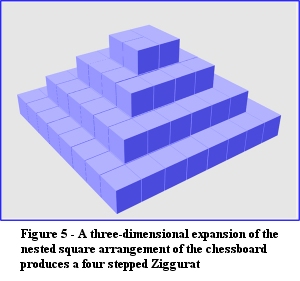 Thus, if we consider each nested square to have a height equal to its length and width them stacking the nested cubes results in a four-stepped Ziggurat as shown in Figure 5. This Ziggurat has been interpreted[XIV] as representing the “world mountain” which the ancients believed was the central axis of the revolving cosmos.
Thus, if we consider each nested square to have a height equal to its length and width them stacking the nested cubes results in a four-stepped Ziggurat as shown in Figure 5. This Ziggurat has been interpreted[XIV] as representing the “world mountain” which the ancients believed was the central axis of the revolving cosmos.
There are a significant number of other esoteric characteristics incorporated into the Chess Board Layout[XV]. The natural symmetric division of the Chess Board into four quadrants taken in the context of astrological symbolism represent the four opposing seasonal cycles. Extension of this symbolism into the art and science of Alchemy would find a correlation between the Chess Board Layout and the so-called “Square of Opposition” of the elements (Figure 6) proposed by Aristotle.
Other characteristics of the Chess Board also fall in line with our current discussion of Astrological associations, namely that the perimeter of the board consists of 28 squares (Figure 7), which correlates with an approximation of the number of days in a monthly lunar cycle.
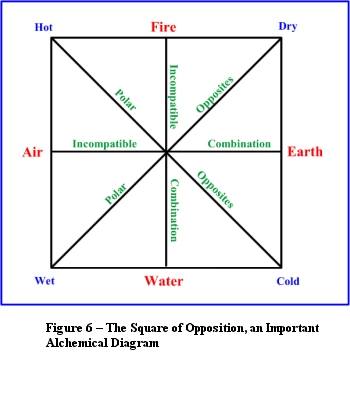
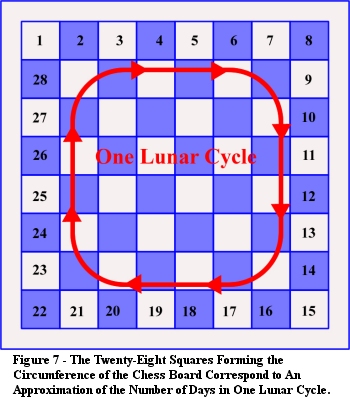
The Chess Pieces
The major chess pieces represent[XVI] the three traditional energy forces analogous to the three forces represented by the Christian Cross (active, passive, and modulating) and which form the Theological basis of the Christian Trinity.
The game is played with a total of thirty-two pieces, sixteen pieces are black and sixteen are white. In each set of sixteen there is one King, One Queen,, Two Bishops, Two Knights, Two Rooks, and Eight Pawns. Figure 8 provides an illustration of the initial placement of the Chess Pieces on the Board.
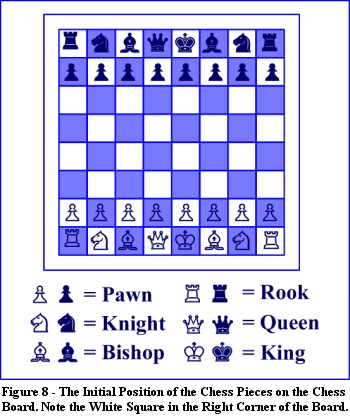 The symbolism of the Chess Pieces is largely found by examination of their function and the range of freedom with which they may move on the board. Brother Manly P. Hall[XVII] aptly describes the role of the Chess Pieces as representative of the spiritual constitution of man. Hall observes in this regard that:
The symbolism of the Chess Pieces is largely found by examination of their function and the range of freedom with which they may move on the board. Brother Manly P. Hall[XVII] aptly describes the role of the Chess Pieces as representative of the spiritual constitution of man. Hall observes in this regard that:
“Of the philosophical constitution of man, the kings represent the spirit; the queens the mind; the bishops the emotions; the knights the vitality; the castles, or rooks, the physical body. The pieces upon the kings’ side are positive; those upon the queens’ side, negative. The pawns are the sensory impulses and perceptive faculties–the eight parts of the soul. The white king and his suite symbolize the Self and its vehicles; the black king and his retinue, the not-self–the false Ego and its legion. The game of chess thus sets forth the eternal struggle of each part of man’s compound nature against the shadow of itself. The nature of each of the chessmen is revealed by the way in which it moves; geometry is the key to their interpretation. For example: The castle (the body) moves on the square; the bishop (the emotions) moves on the slant; the king, being the spirit, cannot be captured, but loses the battle when so surrounded that it cannot escape.”
The pieces may be found to have analogy to planetary bodies, the elements, cardinal direction, and many other forms. In the view of the Chess Board as an Astrological platform, one of the most interesting symbolisms of the Chess Pieces concerns their planetary associations[XVIII]. These planetary associations are consistent with the layout of the Lodge in that the original Blazing Star which was central to the Lodge pavement was a Hexagram [XIX] and not the Pentagram. The Hexagram is itself a common symbol of planetary order.
In the Astrological scheme, as already noted, the King represents the Sun and the Queen represents the Moon. The King may move only one square at a time in any direction (including diagonally). The King captures other pieces by displacement, i.e. assuming the square upon which an opposing piece occupies. The Queen moves freely vertically, horizontally, or diagonally and may do so for any desired distance. The Queen captures by displacement. Bishops move diagonally along squares of similar color (black bishops move on black diagonally connected squares, white bishops on white diagonals).
The Bishop’s pattern of movement is decidedly triangular, and is taken to represent the spiritual world. Astrologically the piece represents the Feminine character and the Planet Jupiter. The Rook moves “on the square”, that is to say either vertically or horizontally. It is taken to represent the Masculine character and therefore Saturn.
The knight is the only piece which can leap over other pieces. It can move two squares up and one square over, or one square up and two over. In this regard the Knight’s movements resemble the Masonic square and represents the planet Mars. Pawns move straight forward one square at a time, except that on the first move they may be advanced two squares. Pawns are unique in that while they normally move forward, they may move forward diagonally when capturing an opposing piece. Pawns which move forward to the final rank may be exchanged for a piece of greater value. In this regard they are metaphors for spiritual advancement and reward. Martinists would consider the pawn a symbol of reintegration both potential and realized. Pawns are considered to represent Venus and Mercury.
The Chess Pieces are also attributed to symbolically represent the four Cardinal Directions[XX] and the four Classical Elements (Fire, Air, Water and Earth).
Conclusion
Chess has gained a reputation for being the game of choice for individuals in possession of a high intellect. It is interesting to note however that medical studies[XXI] performed to evaluate the cognitive function of individuals with a high aptitude for the game of Chess concluded that intelligence is not a factor in success at the game. The existence of so-called “idiot savants” who are Chess prodigies seems to indicate that other factors are responsible for Chess excellence. The Author would speculate that the high esoteric content of the game may have something to do with the unexplained capabilities of persons who are naturally talented Chess players; perhaps in these persons, the Universal Consciousness speaks, and speaks loudly. As for me, I apparently need a new hearing aid.
I feel it is important to address the fact that the squares (and the Chess Pieces) are divided into light and dark shades. Traditionally, this has been taken to represent good and evil (respectively) and the game has been considered to represent a cosmic battle of the forces of light and the forces of darkness.
I believe a better description is possible. Each participant engaged in the game is assigned either light or dark pieces based upon a blind system of draw. It is not likely that either participant truly represents evil, regardless of the shade of Chess Piece he or she is given to play. Much like the esoteric symbolism of the game board and pieces, the struggle in Chess represents that good and evil are relative to the viewpoint of the individual. Certainly during a good Chess match, one’s opponent who is engaged in assaulting your position could be viewed as having evil intent towards one’s King. The opposite might be true as well. I believe this represents a great truth in the Cosmos; namely that life is a struggle against threats both real and perceived, and is a battle waged for the purpose of self-knowledge. The exercise of free will in the context of the Chess game, in which our choices are constrained only by the game rules (natural law) certainly parallels the exercise of free will in our lives. Therefore Chess, with its light and dark squares is a struggle of man with his inner self, waged in a realm consisting of shades of gray.
Notes
[I] Hall, Manly P. (1936). Encyclopedic Outline of Masonic, Hermetic, Qabalistic, and Rosicrucian Symbolical Philosophy. Los Angeles: Philosophical Research Society.
[II] Li, David H. (1998). The Genealogy of Chess. Premier Publishing Company.ISBN-10: 0963785222; ISBN-13: 978-0963785220
[III] Aun Weor, Samael and Khan, Kwen. (2005-2012). Chess: The Symbolism of the Game of Chess. Retrieved March 31, 2012 fvrom http://www.vopus.org/en/gnosis/universal-symbols/chess–the-symbolism-of-the-game-of-chess.html.
[IV] Calvo,Ricardo. (2003-2007). Mystical Numerology in Egypt and Mesopotamia. Chapter 2: Mystical numerology in Egypt and Mesopotamia. McLean, Donald (Ed.). http://www.goddesschess.com/chessays/calvonumerology.html
[V] Daryaee, Touraj. (). The Games of Chess and Backgammon in Sasanian Persia. California State University, Fullerton. Retrieved April 2, 2012 from http://www.humanities.uci.edu/sasanika/pdf/Backgammon-2.pdf.
[VI] Needham, Joseph and Wang, Ling. (1962). Science and Civilisation in China: Volume 4, Physics and Physical Technology, Part 1, Physics. Cambridge University Press. ISBN:9780521058025
[VII] Burckhardt, Titus. The Symbolism of Chess. in Studies in Comparative Religion. Vol. 3, No. 2, Spring 1969. World Wisdom, Inc. Retrieved March 31, 2012 from http://www.studiesincomparativereligion.com/public/articles/The_Symbolism_of_Chess-by_Titus_Burckhardt.aspx.
[VIII] Regardie, Israel. (1984).The Complete Golden Dawn System of Magic. Phoenix, Arizona: Falcon Press.
[IX] Westlund, Tommy (transcipt.). (2007). “Y” Chess and Chaturanga: Parts 1 and 2. Rosicrucian Order of Alpha Omega. Retrieved April 3, 2012 from http://www.rosae-crucis.net/ao_y.pdf.
[X] Green, Dan. (2012). The Mystery of the Octave: Hidden Occult and Supernatural Symbolism In Lincoln Cathedral. Retrieved March 31, 2012 from http://www.perception9.com/occult-and-witchcraft/sorcery-ritual-entities.php?insight=The%20Mystery%20of%20the%20Octave&item=00000203.
[XI] Eyer, Shawn. The Mystery of the Mosaic Pavement. Philalethes. Fall 2009. No. 93. Retrieved March 10, 2012 from http://academialodge.org/pdf/eyer_mystery_of_the_mosaic_pavement.pdf
[XII] Bromwell, Henry P.H. (1909). Restorations of Masonic Geometry and Symbolry: Being a Dissertation of the Lost Knowledges of the Lodge. Denver: The H.P.H. Bromwell Masonic Publishing Company.
[XIII] Burkle, William. Interesting Properties of the Numerical Sequence 3, 5, and 7: A Connection to the Golden Mean Rediscovered. Living Stones Magazine. April 2012, Volume 2, Issue 4.
[XIV] Twyman,Tracy R. (2004). The Merovingian Mythos and the Mystery of Rennes-le-Chateau. Quintessential Publications.
[XVI] Steer, Maxwell. (1997). Music and Mysticism. Routledge. ISBN: 978-3-71-865930-2.
[XVII] Op cit. Hall, Manly P. (1936). Encyclopedic Outline of Masonic, Hermetic, Qabalistic, and Rosicrucian Symbolical Philosophy.
[XVIII] Moore, D.J. (2012). The Symbolism of Chess. Bishop Wilson College of the Societas Rosicruciana In Anglia (SRIA) within the Province of Western Counties and North Wales. Retrieved March 31, 2012 from http://www.bishopwilkins.co.uk/2012/03/the-symbolism-of-chess/.
[XIX] Leadbeater, C.W. (1926) Second Edition. The Hidden Life in Freemasonry. Adyar, Madras, India. The Theosophical Publishing House.
[XX] Dominici, Agostino. Let’s Play Some Chess. New Acropolis. Retrieved March 31, 2012 from http://www.newacropolisuk.org/articles.php?artid=18.
[XXI] Shabazz, Daaim. Metaphysics of the Chess Mind. The Chess Drum’s 65th Square. Retrieved April 2, 2012 from http://www.thechessdrum.net/65thSquare/65_janfeb03.html.